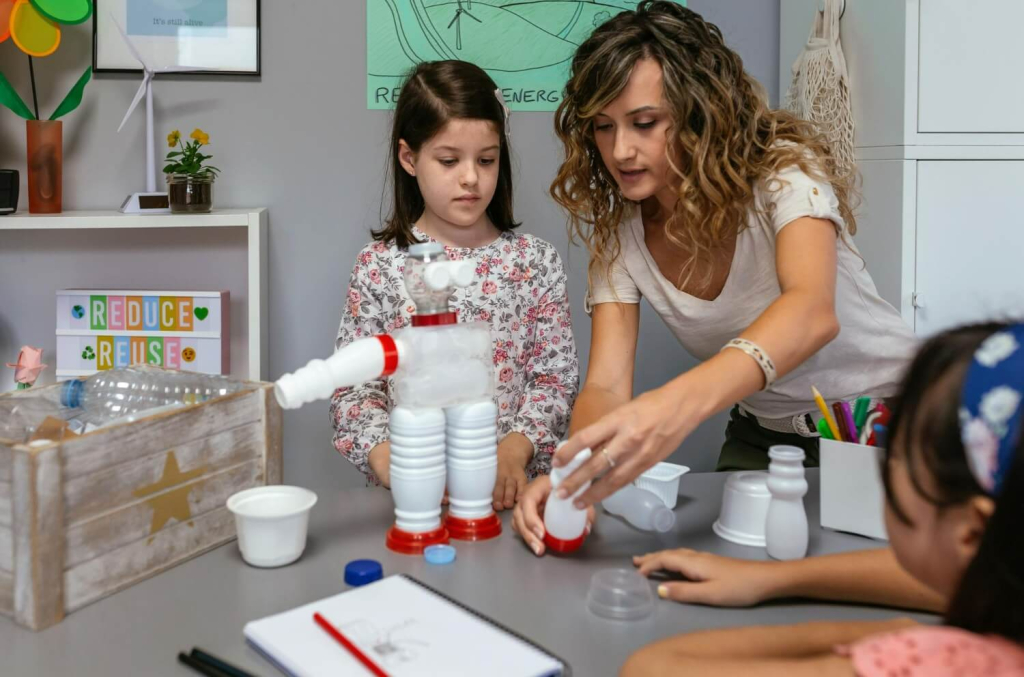
Image source: Freepik
Why Nurturing a Child’s Curiosity Matters
Raising children in the Philippines today means preparing them for a world shaped by science, technology, engineering, and mathematics. Families are surrounded by rapid digital change, unpredictable weather patterns, and growing economic demand for STEM skills across various subjects. These shifts make parent involvement an important aspect of a child’s academic journey. STEM learning is not only about high grades; research shows that when children explore real-world problems through hands-on experiences, they build critical thinking, problem-solving skills, and a lifelong love of science.
This guide offers practical parenting tips for STEM learning rooted in the Philippine context, making sure that families can spark a child’s natural curiosity even with limited time, budget, or technical background.
Creating a Strong Foundation for STEM Learning at a Young Age
Children at a young age absorb patterns, motion, and scientific concepts simply by living their daily routines. When parents treat ordinary activities as opportunities for teaching STEM, children gain early familiarity with how the world works.
Pouring water into a glass demonstrates volume; cooking rice introduces heat transfer and measurement; pushing a toy across the floor shows friction. These moments are not formal STEM lessons but gentle building blocks that establish familiarity with the ideas behind technology, engineering, and mathematics.
These early interactions foster curiosity and help students engage with STEM topics long before textbooks appear. When parents treat questions with patience and interest, they signal that learning is a natural part of life.

Foster Curiosity Through Simple STEM Experiences
Children learn eagerly when activities feel playful rather than formal. When a parent asks a child what they think will happen before a simple science experiment, it transforms the moment into a chance for critical thinking. Simple, low-cost investigations strengthen STEM learning by showing how scientific concepts unfold through small, accessible reactions.
Using Everyday Household Materials for Simple Science Experiments
Household materials are ideal for hands-on experiences. A cardboard tube becomes a ramp for rolling objects, revealing gravity and speed. A reused bottle becomes a mini greenhouse for observing how plants grow. Even a walk outside offers chances for exploring nature, spotting patterns, and encouraging children to ask questions.
Mixing vinegar and baking soda introduces chemical reactions, and allowing students to control the amounts strengthens their problem-solving mindset. Homemade water filters using sand, stones, and cloth highlight filtration principles and show how real-world connections form between science and daily living. Ice-and-salt melting experiments demonstrate temperature and phase change.
These hands-on experiments teach students interested in how things work that inquiry is a process, not an event. Each setup encourages deeper understanding by letting children repeat, adjust, and observe results.
Teaching Basic Math Concepts Through Play
Play is an effective way to teach kids early mathematics. A pretend sari-sari store encourages addition, subtraction, and comparison. Pattern-building games introduce sequencing. Pouring water between containers of different shapes strengthens concepts of volume.
These playful interactions become early STEM experiences that help students engage without pressure. When children are relaxed, their brain forms stronger connections, making future STEM topics easier to grasp. Parents can spark curiosity simply by letting children lead the play while gently guiding the math concepts behind each activity.

Strengthening Critical Thinking Skills Through Hands-On Projects
As children grow, they benefit from extended tasks that require planning, testing, and adjusting. Hands-on STEM projects develop important thinking habits and problem-solving skills. When parents give space for trial-and-error, children learn that mistakes are information rather than failures. This approach strengthens confidence and leads to creative solutions that come from within the child, not the parent.
Setting Up Hands-On Experiments That Support Deeper Understanding
Projects like rubber-band boats, mini parachutes, or cardboard weather vanes help children explore physics through touch and movement. By testing how different materials behave, children develop STEM knowledge through firsthand experience.
They learn that small adjustments influence outcomes, reinforcing critical thinking skills. When students document their results, they internalise scientific processes and gain clarity on cause-and-effect reasoning.
Giving Children Space for Creative Problem Solving
Parents often solve problems quickly for convenience, but allowing students to struggle productively nurtures independence. Offer engineering challenges such as building a bridge from barbecue sticks or designing a container that keeps ice from melting.
Give a few ideas at the start, then let children take the lead. This freedom fosters curiosity, strengthens resilience, and teaches real-world connections between ideas and results. Project-based learning like this teaches that science is active, not passive.
Connecting STEM Principles to the Natural World
The natural world remains one of the most effective environments for teaching STEM principles. Outdoor environments reveal patterns, cycles, and changes that books alone cannot convey. When children spend time exploring nature, they learn to observe, ask questions, and connect experiences to scientific concepts.

Observing How Plants Grow
Growing plants offers children immediate insight into biology. Parents can set up seed germination experiments or small container gardens where children record growth height, leaf count, and watering schedules. If families live in communities with accessible outdoor spaces, they can observe sunlight, soil, and moisture differences.
In developments such as Camella Altamira in Silang, Cavite, the surrounding greenery and landscaped areas allow families to use spacious parks as open-air classrooms, turning casual walks into living lessons on how plants grow. The natural world becomes a direct source of STEM principles that children can observe repeatedly.
Exploring Weather Patterns and Other Scientific Concepts
The weather changes constantly in the Philippines. Tracking rainfall, checking cloud formations, or recording wind direction teaches children to gather data over time. This helps them understand real-world problems such as flooding or heatwaves caused by climate change. By comparing notes across days, students engage in pattern recognition, a core part of STEM learning. Parents can extend these observations into simple graphs that build math concepts and critical thinking.
Introducing the Solar System Through Simple Visual Tools
Space captures children’s imagination effortlessly. Parents can use mobile apps to show how the solar system moves, identify stars, and observe the moon’s phases. Some universities and astronomy groups host safe, child-friendly viewing sessions where kids can see planets through telescopes. Observing the night sky turns abstract space topics into memorable STEM experiences that children carry with them.
Making Climate Change a Meaningful Context for STEM Lessons
Climate change affects Filipino families directly, which makes it an effective starting point for teaching STEM concepts. Parents can help children observe rainfall patterns, create simple solar-powered devices, or monitor local flooding behaviour during storms. These observations help children connect scientific concepts to daily challenges and consider potential solutions.
Climate-related projects encourage students to think critically about environmental change while practising data collection, analysis, and reflection. When children engage with real-world problems early, they learn that science offers practical tools to solve problems.

Image source: https://www.freepik.com/premium-photo/wear-view-family-looking-fish-tank_1699349.htm#from_element=cross_selling__photo
Enhancing Learning Through Field Trips and Community Involvement
Field trips extend learning beyond the home and show children that science exists everywhere. Visiting interactive spaces, museums, and community events gives children real-world connections they cannot find in worksheets alone. Parents strengthen student engagement by preparing children before visits and discussing observations afterwards.
Visiting Science Museums and Local Learning Spaces
Science museums offer hands-on experiences that reinforce STEM principles. Places like MindSpark in Parañaque and The Mind Museum in Taguig provide interactive exhibits suited for different ages, letting students explore physics, biology, engineering, and technology concepts through touch and movement. Exhibits on robotics, space, and ecosystems allow children to see theory applied in physical space. These trips spark curiosity and motivate students interested in STEM fields to pursue more STEM activities at home.
Joining Community Activities That Support Social Responsibility
Community involvement links STEM education to real-world problems. Coastal cleanups, tree planting, and citizen-science mapping allow students to gather data, classify materials, and contribute to potential solutions for climate change. Participating in these activities shows children how science, social responsibility, and teamwork intersect. Parents can encourage children to reflect on their role in the community, turning outdoor participation into meaningful learning that aligns with STEM principles.
Supporting Parent Involvement With Accessible STEM Education Tools
Parents who feel unsure about teaching STEM can lean on reliable online resources. These tools help teach kids various subjects and deepen a child’s interests through guided modules. With clear routines, online resources become powerful supplements to hands-on experiences at home.
Parents can ask their child’s school if DepEd platforms like DepEd Commons and DOST-STARBOOKS are available for them to access. Alternatively, global learning websites like Khan Academy offer free materials covering STEM content from basic math concepts to technology, engineering and mathematics pathways.
These websites help parents explain scientific concepts, plan simple science experiments, and assist with STEM lessons after school. Regular access to online resources strengthens student engagement by giving children structured tutorials and videos that expand their STEM knowledge.

Sustaining a Lifelong Love for STEM Learning at Home and Beyond
Long-term interest grows from consistent habits, not occasional activities. Families can keep STEM learning alive by maintaining observation journals, setting up weekend nature walks, or encouraging curiosity-led discussions at the dinner table. These routines keep scientific thinking active and help children process their experiences.
When parents show enthusiasm for learning, children develop confidence in exploring new ideas. Over time, these choices cultivate a lifelong love of science, strengthen STEM skills, and nurture children into independent thinkers capable of tackling challenges in a changing world.
Conclusion
Supporting STEM learning at home doesn’t require advanced knowledge; it requires presence, curiosity, and consistent opportunities for exploration. When parents weave STEM activities into daily life—from simple experiments to nature observations, from community involvement to conversations with role models—children gain STEM knowledge that shapes their academic journey and their future.
These experiences form the strong foundation students need to understand real-world problems and explore STEM careers if they choose to. With patience, encouragement, and environment-rich learning, parents can raise confident young problem solvers eager to discover the endless possibilities that science and learning bring into their lives.


